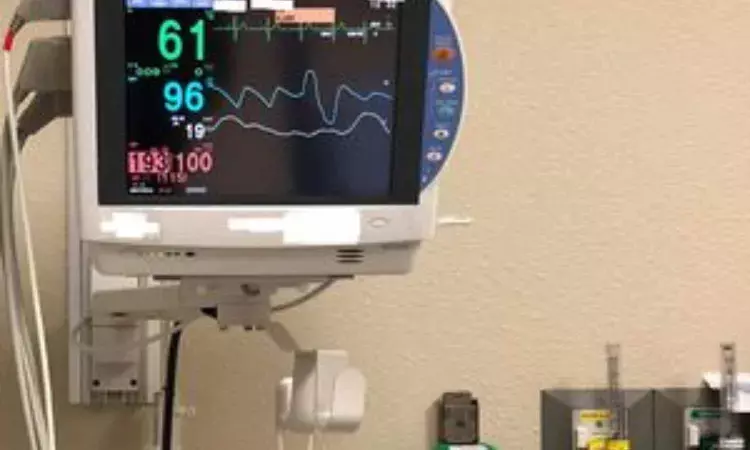- Home
- Medical news & Guidelines
- Anesthesiology
- Cardiology and CTVS
- Critical Care
- Dentistry
- Dermatology
- Diabetes and Endocrinology
- ENT
- Gastroenterology
- Medicine
- Nephrology
- Neurology
- Obstretics-Gynaecology
- Oncology
- Ophthalmology
- Orthopaedics
- Pediatrics-Neonatology
- Psychiatry
- Pulmonology
- Radiology
- Surgery
- Urology
- Laboratory Medicine
- Diet
- Nursing
- Paramedical
- Physiotherapy
- Health news
- Fact Check
- Bone Health Fact Check
- Brain Health Fact Check
- Cancer Related Fact Check
- Child Care Fact Check
- Dental and oral health fact check
- Diabetes and metabolic health fact check
- Diet and Nutrition Fact Check
- Eye and ENT Care Fact Check
- Fitness fact check
- Gut health fact check
- Heart health fact check
- Kidney health fact check
- Medical education fact check
- Men's health fact check
- Respiratory fact check
- Skin and hair care fact check
- Vaccine and Immunization fact check
- Women's health fact check
- AYUSH
- State News
- Andaman and Nicobar Islands
- Andhra Pradesh
- Arunachal Pradesh
- Assam
- Bihar
- Chandigarh
- Chattisgarh
- Dadra and Nagar Haveli
- Daman and Diu
- Delhi
- Goa
- Gujarat
- Haryana
- Himachal Pradesh
- Jammu & Kashmir
- Jharkhand
- Karnataka
- Kerala
- Ladakh
- Lakshadweep
- Madhya Pradesh
- Maharashtra
- Manipur
- Meghalaya
- Mizoram
- Nagaland
- Odisha
- Puducherry
- Punjab
- Rajasthan
- Sikkim
- Tamil Nadu
- Telangana
- Tripura
- Uttar Pradesh
- Uttrakhand
- West Bengal
- Medical Education
- Industry
Predicting the Unpredictable: Study finds Insights into Intraoperative Hypotension through HPI Evaluation

In a recent study comparing the Hypotension Prediction Index (HPI) values obtained from Acumen arterial pressure transducer and ClearSight continuous non-invasive blood pressure monitor, the primary objective was to assess the potential impact on intraoperative hypotension incidence and perioperative complications. Intraoperative hypotension is a significant concern due to its association with increased post-operative morbidities and mortalities, with 40% to over 90% of patients experiencing at least one hypotensive episode during general anesthesia. The HPI provides early warning of critical hypotension, aiding in earlier interventions to reduce its incidence. The HPI algorithm analyzes arterial pressure waveform features to predict hypotension, demonstrating over 80% sensitivity and specificity in previous studies.
Comparison of Monitoring Systems
The study compared HPI values obtained from invasive and non-invasive pressure inputs in adult patients undergoing general anesthesia. The data analysis included Bland-Altman analysis, correlation calculations, and concordance assessments to evaluate the agreement between the two monitoring systems. The results showed a bias of -8.4 between invasive and non-invasive HPI values, with a high correlation of 0.76. The concordance rates remained consistent across different exclusion zones, indicating a reliable agreement between the two systems.
Clinical Performance Evaluation
The clinical performance evaluation included Receiver Operator Characteristic (ROC) analyses and HPI alerts agreement analysis. Both invasive and non-invasive systems showed comparable performance in predicting hypotensive events, with similar Area Under the Curve (AUC) measurements, sensitivity, specificity, positive predictive values (PPV), and negative predictive values (NPV) at different time intervals before hypotensive events.
Conclusion
The study concluded that the HPI derived from the non-invasive ClearSight monitor exhibited reliable predictive performance comparable to the gold standard invasive arterial catheter. This suggests that the non-invasive HPI can be used effectively for continuous blood pressure monitoring in various surgical scenarios, potentially improving patient outcomes by predicting and preventing hypotensive episodes. However, the study highlighted the need for caution in generalizing the results to other patient populations and emphasized the importance of further validation in larger cohorts. Overall, utilizing the HPI parameter from non-invasive monitoring systems could enhance the management of intraoperative hypotension and reduce perioperative complications in a wider range of surgical procedures.
Key Points
- The primary objective of the study was to evaluate the impact of using the Hypotension Prediction Index (HPI) from Acumen™ arterial pressure transducer and ClearSight™ continuous non-invasive blood pressure monitor on intraoperative hypotension incidence and perioperative complications.
- Intraoperative hypotension is a major concern during general anesthesia as it is linked to increased post-operative morbidities and mortalities, affecting a significant percentage of patients. The HPI algorithm, with over 80% sensitivity and specificity, can predict critical hypotension early, allowing for timely interventions.
- The study compared HPI values from invasive and non-invasive pressure inputs in adult patients under general anesthesia, revealing a bias of -8.4 between the two systems with a high correlation of 0.76, demonstrating reliable agreement.
- Clinical performance evaluation using Receiver Operator Characteristic (ROC) analyses and HPI alerts agreement analysis showed that both invasive and non-invasive systems had similar predictive performance in detecting hypotensive events, with comparable Area Under the Curve (AUC) measurements, sensitivity, specificity, positive predictive values (PPV), and negative predictive values (NPV).
- The study concluded that the non-invasive HPI derived from the ClearSight monitor exhibited reliable predictive performance similar to invasive arterial catheters, suggesting its effectiveness for continuous blood pressure monitoring in various surgical settings. However, caution is advised in generalizing the results to other patient populations, emphasizing the importance of further validation in larger cohorts.
- Utilizing the HPI parameter from non-invasive monitoring systems could enhance the management of intraoperative hypotension and decrease perioperative complications across a broader spectrum of surgical procedures, potentially leading to improved patient outcomes.
Reference –
Kamron Sarhadi et al. (2025). Hypotension Prediction Index: Comparison Between Invasive And Non-Invasive Pressure Inputs. *BMC Anesthesiology*, 25. https://doi.org/10.1186/s12871-025-03086-y.
MBBS, MD (Anaesthesiology), FNB (Cardiac Anaesthesiology)
Dr Monish Raut is a practicing Cardiac Anesthesiologist. He completed his MBBS at Government Medical College, Nagpur, and pursued his MD in Anesthesiology at BJ Medical College, Pune. Further specializing in Cardiac Anesthesiology, Dr Raut earned his FNB in Cardiac Anesthesiology from Sir Ganga Ram Hospital, Delhi.


